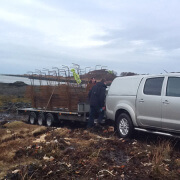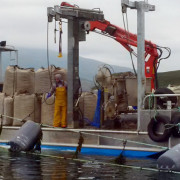A local saying in Shetland is “never cast a cloot till da mont o May is oot” and for those of you who don’t know what a cloot is – it refers to clothing and is an offering of wisdom suggesting it is not wise in to get too summery with your wardrobe choices till June. Well if the weather recently has been anything to go by I would certainly agree with this advice.
Wind, rain, more wind and some snow has marked the last few weeks and I should know this was always going to be the case as soon as we lifted out our workboat to clean and paint a few weeks ago. Progress has thus been slow due to the weather delays but as I write - the forecast for the coming week is looking more promising so we hope to get the boat back in the water soon.
There is certainly plenty of work for the boat in the planner to be getting on with. We have been harvesting plenty of mussels recently with our other boat as always, but this is also the season to get new ropes into the sea to catch the juvenile mussels, and we always aim to get this done late spring and early summer. Our marine biology is a little behind our mainland Scotland colleagues, given we are so much further north, but time marches on very quickly and once the sea temperatures start to accelerate we need to be ready.
This year we will be putting around 30,000 ropes to sea to collect the small mussels. These go to our most sheltered sites which give us the best chance of getting good settlement of mussels. It is not an exact science however and for various reasons some years the spat collection is not as good as we would like. This is a big worry for us as we need mussels to make our farm operate.
This year for the first time we will also be trialling a totally new method of spat collection with the beginning of the Scottish Shellfish Hatchery Stepping Stone Project here in Shetland. Scottish Shellfish along with experts at NAFC will be using a hatchery to breed juvenile mussels to put out to our sites throughout the summer.
If successful it would give us a new source of mussels to grow on our farms. But it is early days and there are more questions than answers at this stage so we will just have to see how it goes but exciting times none the less.
In the meantime we just need to focus on meeting our biological deadlines so if we could just get enough dry days to get this boat back in the water, we could then launch her and then get on with the 30,000 ropes we need to get in the sea. As ever we are totally tied to nature in this business but we wouldn’t have it any other way.
View our timelapse video below.









